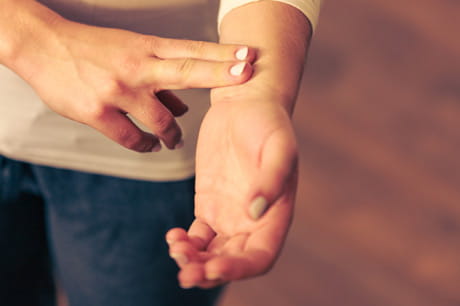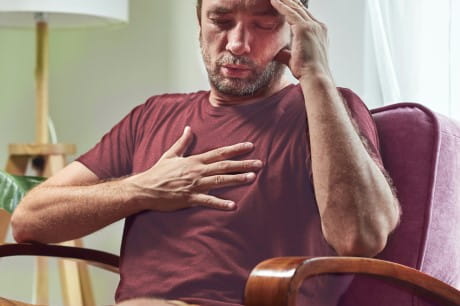4 reasons behind an irregular heartbeat
Pay attention to your heartbeat
People say, “My heart skipped a beat,” when they’re scared or excited. But an irregular heartbeat is actually much more common than you’d think.
“An irregular heartbeat is called an arrhythmia,” says Dr. Pugazhendhi Vijayaraman, cardiac electrophysiologist and director of cardiac electrophysiology at Geisinger Northeast. “There are many different types, which can be temporary or permanent. Often, arrhythmias are harmless; however, if you feel a persistent irregular heartbeat, see a doctor.”
One type of arrhythmia, a premature ventricular contraction, or PVC, is the most common type of irregular heartbeat.
A PVC happens when the heart beats too early, which causes a stronger second beat. This causes a fluttering or pounding sensation in the chest. Most people have at least one PVC every day, and many don’t even notice it.
Things like caffeine, alcohol and stress can cause small, temporary arrhythmias like PVCs. But there are factors that can cause permanent arrhythmias, too.
Here are four potential causes of a persistent, irregular heartbeat:
-
Coronary artery disease
Your arteries are highways for oxygen and nutrients. However, fat, cholesterol and calcium can build plaques in the arteries, causing coronary artery disease. These plaques make it difficult for blood to flow and can put pressure on the heart.
“Coronary artery disease weakens the heart by putting it under too much pressure,” says Dr. Vijayaraman. “As the heart weakens, irregular heartbeats can develop.”
Coronary artery disease can cause dangerous arrhythmias like atrial fibrillation, or AFib. It’s a rapid, quivering heartbeat that can lead to heart palpitations, blood clots, heart attack and stroke.
-
Heart surgery
Heart surgery is a life-saving operation—it can remove clots and help you get your life back.
But, operating on the heart can change the way the heart works, including the way your heart beats. Heart surgery can increase your risk of arrhythmias, so your doctors will often monitor your heart after surgery.
-
Changes in your heart muscle
If you’ve had a heart attack, you may have scar tissue on your heart muscle. This scar tissue can cause the heart to beat irregularly by restricting or changing the heart.
After a heart attack, there is also risk of cardiomyopathy or an abnormality of the heart. With cardiomyopathy, your heart may swell and make it harder to pump blood. This can also lead to arrhythmia.
-
Electrolyte imbalance
You’ve likely heard of electrolytes in sports drinks, but they relate to your heart, too.
“Electrolytes are small traces of metal that conduct electricity, which allows the heart to beat,” explains Dr. Vijayaraman . “Sodium, magnesium, potassium and calcium are all examples of electrolytes. If you have too many or too few electrolytes in your body, it can change the way your heart beats.”
When to see a doctor
While PVCs are normally harmless, certain types of arrhythmias, like atrial fibrillation and ventricular fibrillation (VFib), can lead to cardiac arrest and heart attack. VFib can paralyze the heart—making it unable to pump blood. If left untreated, VFib can lead to cardiac arrest.
If you feel a persistent irregular heartbeat, your doctor can help diagnose the type of arrhythmia and monitor your heart. They may refer you to an Electrophysiology (EP) lab, where they can test, diagnose and treat arrhythmias.
Get emergency medical attention if you experience dizziness, fainting, shortness of breath and pain in your chest. These symptoms could be a sign of a severe arrhythmia and heart attack. Similarly, if you notice numbness on one side of your body, confusion, facial drooping and muscular weakness, these symptoms could be a sign of a stroke.
Next steps:
Meet Pugazhendhi Vijayaraman, MD
Learn about heart care at Geisinger





